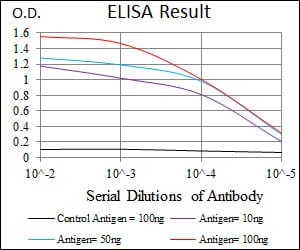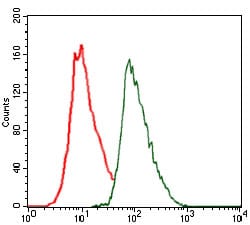


| WB | 1/500 - 1/2000 | Human,Mouse,Rat |
| IF | 咨询技术 | Human,Mouse,Rat |
| IHC | 咨询技术 | Human,Mouse,Rat |
| ICC | 技术咨询 | Human,Mouse,Rat |
| FCM | 1/200 - 1/400 | Human,Mouse,Rat |
| Elisa | 1/10000 | Human,Mouse,Rat |
| Aliases | CEBP; C/EBP-alpha |
| Entrez GeneID | 1050 |
| clone | 4E10 |
| WB Predicted band size | 37.5kDa |
| Host/Isotype | Mouse IgG1 |
| Antibody Type | Primary antibody |
| Storage | Store at 4°C short term. Aliquot and store at -20°C long term. Avoid freeze/thaw cycles. |
| Species Reactivity | Human |
| Immunogen | Purified recombinant fragment of human CEBPA expressed in E. Coli. |
| Formulation | Purified antibody in PBS with 0.05% sodium azide |
+ +
以下是关于CEBPA抗体的3篇代表性文献及其简要摘要:
---
1. **文献名称**:*CEBPA mutations in acute myeloid leukemia: A comparative analysis of different antibody-based detection methods*
**作者**:Pabst, T., Mueller, B.U.
**摘要**:该研究比较了多种CEBPA抗体在检测急性髓系白血病(AML)患者中CEBPA基因突变的应用效果,发现特异性抗体在区分野生型和突变型蛋白中具有高敏感度,可用于临床突变筛查。
---
2. **文献名称**:*Immunohistochemical detection of CEBPA in myelodysplastic syndromes: Correlation with genetic alterations*
**作者**:Dufour, A., et al.
**摘要**:通过免疫组化技术(使用CEBPA特异性抗体)分析骨髓增生异常综合征(MDS)患者样本,发现CEBPA蛋白表达缺失与基因突变及不良预后显著相关,提示抗体检测在MDS分层中的价值。
---
3. **文献名称**:*Biallelic CEBPA mutations in AML: Insights from antibody-based protein expression profiling*
**作者**:Kosmider, O., et al.
**摘要**:研究利用CEBPA抗体对双等位基因突变的AML患者进行蛋白表达分析,发现突变导致CEBPA功能丧失,抗体检测可辅助鉴别此类患者并指导靶向治疗策略。
---
如需具体文献来源或更多细节,可进一步提供研究方向(如疾病类型或实验方法)以便精准推荐。
The CEBPA (CCAAT/enhancer-binding protein alpha) antibody is a crucial tool in molecular and cancer research, targeting the CEBPA transcription factor involved in cellular differentiation, metabolism, and immune responses. CEBPA regulates genes critical for granulocyte and adipocyte development, glucose homeostasis, and cell cycle control. Its role in hematopoiesis makes it a focus in acute myeloid leukemia (AML) studies, where mutations or dysregulation of CEBPA are linked to leukemogenesis.
CEBPA antibodies are widely used in techniques like Western blotting, immunohistochemistry, and flow cytometry to detect protein expression, localization, and mutations. These antibodies help identify CEBPA’s dual isoforms (p42 and p30), with isoform imbalances often associated with AML prognosis. Researchers also employ them to study CEBPA’s interactions with other proteins or DNA, shedding light on its regulatory networks.
Commercial CEBPA antibodies are typically raised in rabbits or mice, with validation in specific applications. Their specificity is critical, as cross-reactivity with other CEBP family members (e.g., CEBPB or CEBPD) can confound results. Clinically, CEBPA antibody-based assays aid in diagnosing AML subtypes and guiding therapeutic strategies, particularly for patients with CEBPA mutations. Ongoing research continues to explore its role in solid tumors and metabolic disorders, underscoring its versatility in biomedical studies.
×